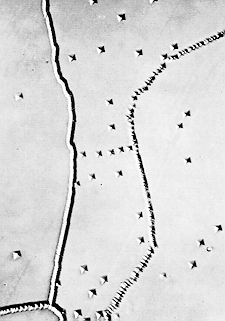|
|
The
dislocation density is a measure of the number of dislocations in a unit
volume of a crystalline material. Two methods are used to measure this
parameter. In the first, the total length of dislocation line in a unit
volume is measured and divided by the volume to give rD
= (L / 13) m-2.
In the second method the number of dislocation lines crossing unit area
in the sample is counted to give: rD
= (n/12)
m-2. This
second method is frequently easier to apply with the dislocations being
revealed by chemical etching. A count of the number of etch pits per unit
area on the etched surface gives the dislocation density.
The
photograph shows the etched surface of a LiF crystal. The high linear etch
pit densities corresponds to dislocations associated with grain boundaries,
the individual (square pyramid) etch pits correspond to individual dislocations. |
|
|
